ALLIES PLUCK LEBANON, SYRIA FROM AXIS GRIP
Beirut, Lebanon • July 12, 1941
During their advance on the Iraqi capital of Baghdad in May 1941, the British were harassed by Luftwaffe aircraft (Heinkel bombers and Messerschmitt fighters) flown in support of the pro-German Iraqi government of Prime Minister Rashid Ali al‑Gaylani. (Al‑Gaylani or El‑Ghalani, who helped found the anti-Western and anti-Semitic Muslim Brotherhood, had led a nationalist coup that unseated a pro-British regime weeks before and was understood to be negotiating for German military support while hosting spies and commando agents known as the Brandenburgers working for Adm. Wilhelm Canaris’s Abwehr, or German military intelligence.) The nearest Axis bases were on the eastern Aegean island of Rhodes. The British deduced that the aircraft had to first land somewhere between Rhodes and Iraq to be able to fly to Baghdad. The only possible spot was Syria, which, like neighboring Lebanon, was garrisoned by soldiers of Marshal Philippe Pétain’s Vichy France (Armée du Levant, Army of the Levant) under the command of Vichy High Commissioner Gen. Henri Dentz. The Vichy garrisons in Syria and Lebanon were artifacts of Franco-German collaboration following the fall of France in June 1940; a May 1941 protocol (implemented but never ratified) allowed Pétain’s rump French state to continue garrisoning and administering France’s overseas territories in exchange for ceding Germany and Italy the use of military bases in Syria, Tunisia, and West Africa and reduced occupation costs.
Operation Exporter, the invasion of Syria and Lebanon by British Commonwealth and Free French Forces (Forces françaises libres) infantry, armored units, and aircraft, began on the morning of June 8, 1941. It followed on the heels of a 5,800‑strong Commonwealth march on Baghdad that imposed a British-Iraqi armistice days before. Vichy French troops vigorously resisted British and Australian columns moving into Lebanon from Palestine, the latter a British mandate under the League of Nations. In support of Vichy forces German aircraft attacked British warships off the Syrian coast in the first clear-cut case of Vichy and Germany fighting on the same side. Eventually Vichy resistance was overwhelmed and, when combined with the destruction of German airbases in Syria by eastward-driving Free French forces and a British-led advance on Damascus from Iraq, Gen. Dentz negotiated an armistice in Acre (in modern Israel) on this date, July 12, 1941.
The armistice placed Syria under Gen. Charles de Gaulle, head of the Free French Forces. The Syria-Lebanon campaign cost the British/Commonwealth force and the Free French more than 7,500 dead and wounded, in comparison to about 6,500 Vichy French. Vichy troops were allowed to surrender with full honors of war and were given the opportunity to join the Free French. Less than half, about 6,500, did so; the rest returned to France.
British Prime Minister Winston Churchill’s dispatch of troops to topple the pro-German military junta in Iraq and the Allied occupation of Lebanon and Syria conferred 5 strategic benefits on the victors: it restored stability in a critical area of the Middle East, it foiled German attempts to gain control or influence over these states and neutral Iran (Persia), it prevented the German Luftwaffe from using Vichy French-controlled Syria and Lebanon as bases for attacks on nominally independent Egypt and the British-controlled Suez Canal, it ensured a stable supply of Middle Eastern oil to the Allies, and it assured the British that the crucial overland route between Egypt and India—the most precious jewel in the Imperial Crown—would be barred forever to German armed forces.
Operation Exporter: The Syria-Lebanon Campaign, June 8 to July 14, 1941
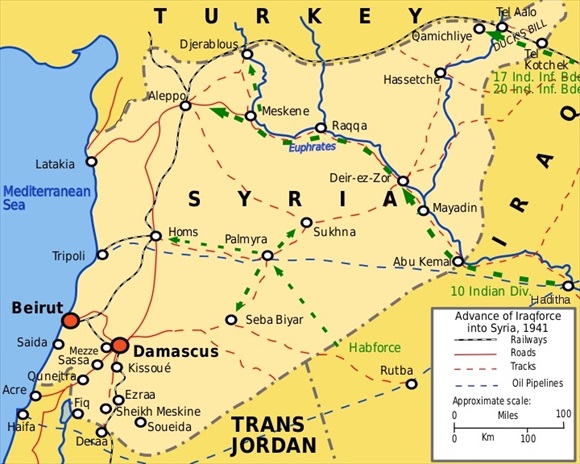 |
Above: Movement of Allied forces into Syria and Lebanon during Operation Exporter (aka the Syria-Lebanon Campaign), June 8 to July 14, 1941. Australians comprised the largest number of Allied combatants (18,000 men), followed by British (9,000), Free French Forces (5,000), and Indian (2,000) forces. On the Vichy side there were 8,000 French and 25,000 Syrians and Lebanese. Vichy French casualties numbered between 6,352 and 8,912 (depending on the source), British/Commonwealth and Free French, 4,652.
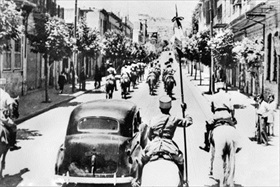 | 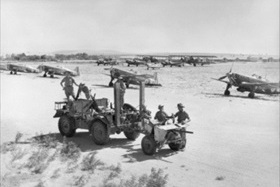 |
Left: The fall of the Syrian capital of Damascus to a combined British, Australian, Free French, and Indian infantry, June 18–21, 1941, after Gen. Dentz decided to abandon the capital. A car carrying two Free French commanders, escorted by Vichy French cavalry, enters the city in this photo.
![]()
Right: Australian troops at the French Aleppo airfield, Syria, June 1941. In the background are Morane-Saulnier MS.406 fighters. The initial 5-to-1 advantage the Vichy French Air Force (Armée de l’Air de Vichy) enjoyed over the RAF and the Royal Australian Air Force quickly evaporated. Most Vichy aircraft were destroyed on the ground. In all, Vichy forces lost 179 aircraft from about 289 that had been committed to defending French Syria and Lebanon. The Australians remained in Aleppo to defend the northern parts of Syria against a possible invasion by German forces through Turkey. The probability of that happening in 1941 was next to zero given Hitler’s fixation with liquidating the Soviet Union (Operation Barbarossa).
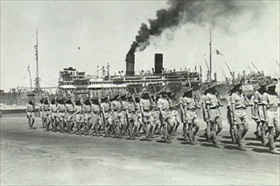 | 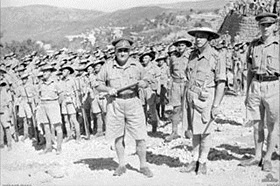 |
Left: The Battle of Beirut (July 12, 1941) marked the end of hostilities in the Syria-Lebanon Campaign. The entry of the Australian 7th Division into Beirut successfully established the Allied occupation of Lebanon. Beirut later became an important Allied base for Mediterranean naval operations. This photo shows members of the Australian 7th Division, 2/25th Battalion in Beirut, September 12, 1941. The 2/25th Battalion, which had earlier entered the Syrian capital Damascus on June 21, was employed on garrison duties along the coast after the mid-July armistice came into effect.
![]()
Right: Maj. Gen. Arthur Allen (center), commander of the Australian 7th Division, inspects some of his men east of Beirut, September 1941.
Middle East Cockpit: Allies versus Axis During World War II
![]()

 History buffs, there is good news! The Daily Chronicles of World War II is now available as an ebook for $4.99 on Amazon.com. Containing a year’s worth of dated entries from this website, the ebook brings the story of this tumultuous era to life in a compelling, authoritative, and succinct manner. Featuring inventive navigation aids, the ebook enables readers to instantly move forward or backward by month and date to different dated entries. Simple and elegant! Click
History buffs, there is good news! The Daily Chronicles of World War II is now available as an ebook for $4.99 on Amazon.com. Containing a year’s worth of dated entries from this website, the ebook brings the story of this tumultuous era to life in a compelling, authoritative, and succinct manner. Featuring inventive navigation aids, the ebook enables readers to instantly move forward or backward by month and date to different dated entries. Simple and elegant! Click 











